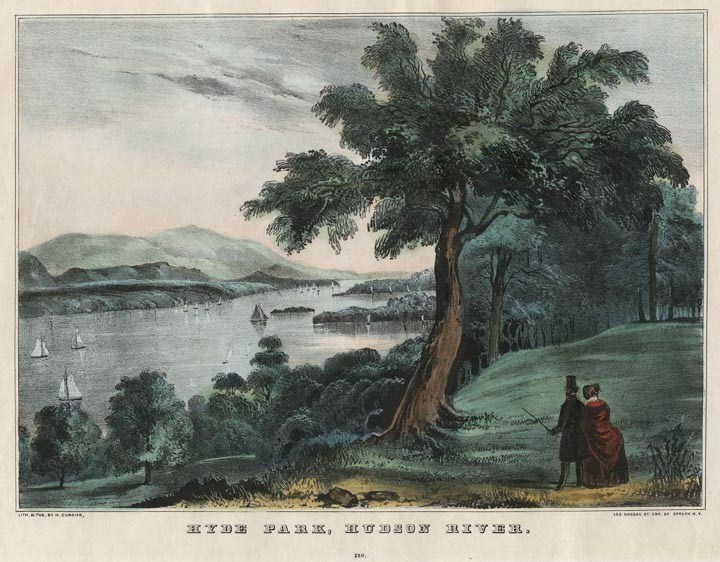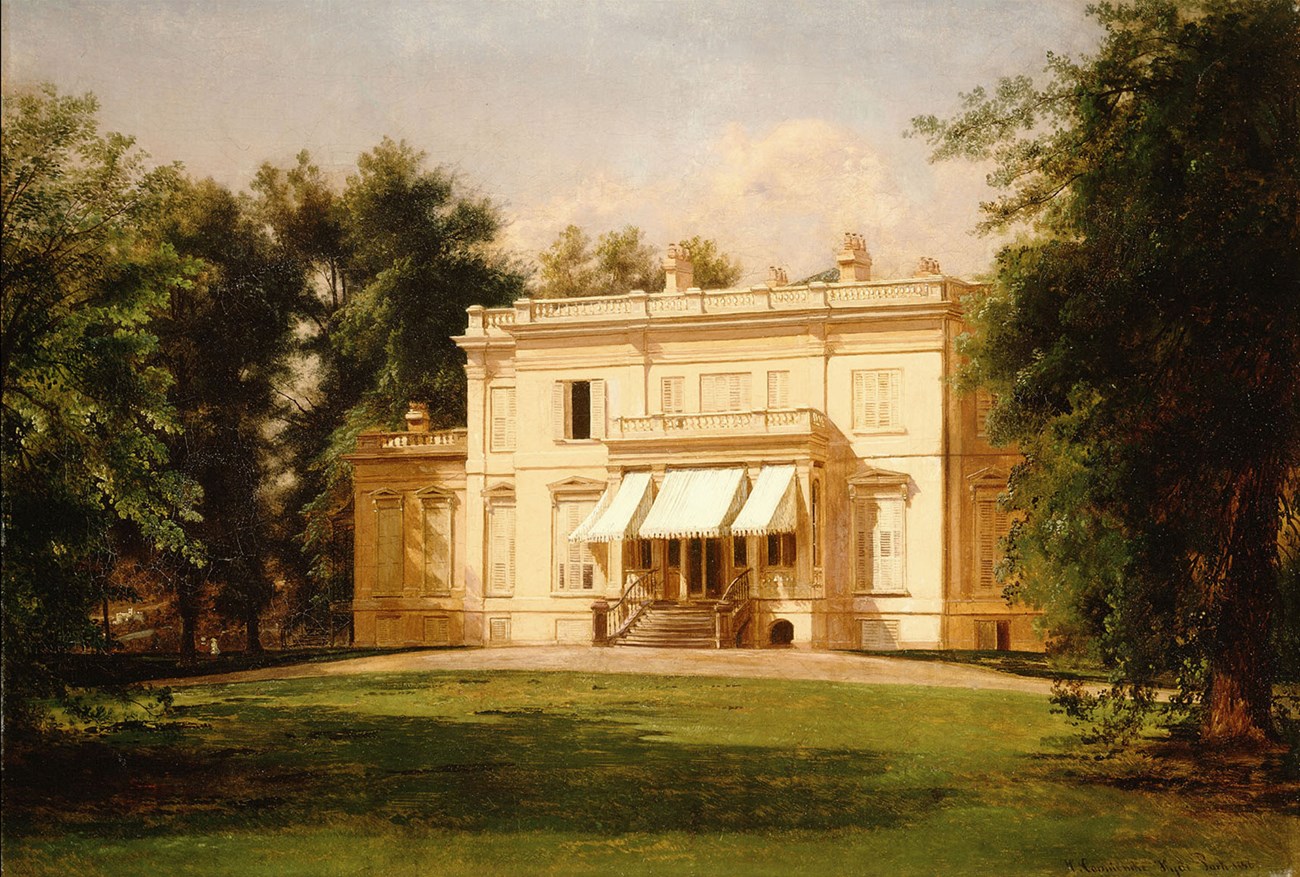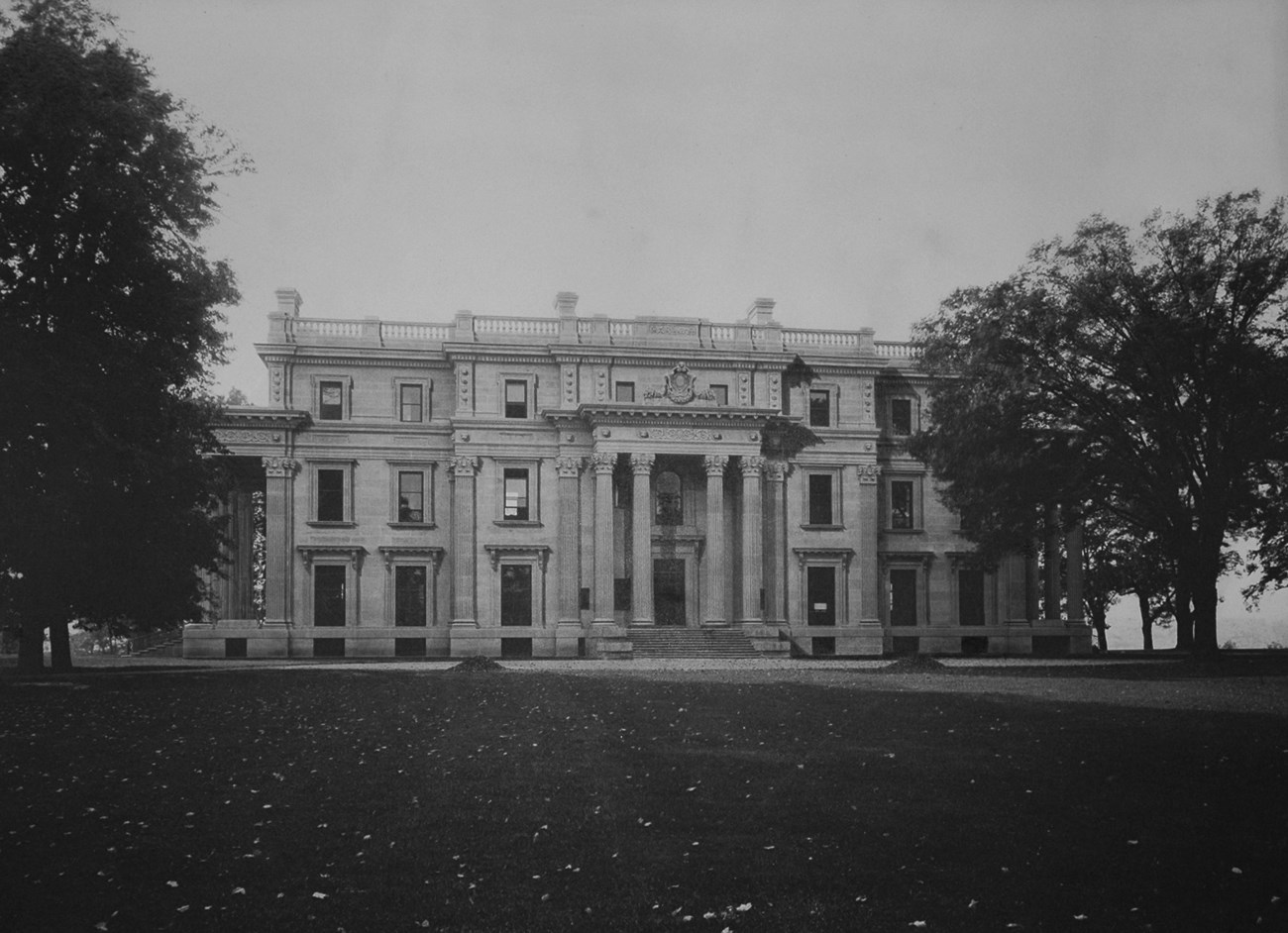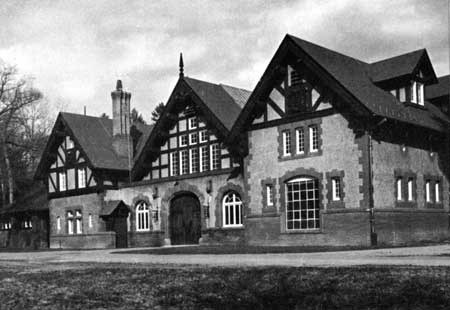Last updated: August 12, 2020
Article
A History of the Hyde Park Estate

NPS Photo
The Vanderbilt estate traces its origins to John Bard, who purchased the 3,600-acre Fauconnier Grant in 1764 and established “Hyde Park,” which became one of the most renowned of the Hudson Valley estates. In 1772 Bard built a house along the east side of the Albany Post Road also known as the “Red House,” and a secondary residence across the road known as Bard Cottage. He also maintained a farm, mills, a store, and three boat landings along the Hudson, the southerly one known as Hyde Park Landing and the northerly called Bard’s Rock. The estate bordered Crum Elbow Creek to the south, adjoining a small hamlet that later took the name of the estate. In 1799 Bard left the 1,500-acre core of the estate to his son, Samuel. The younger Bard was responsible for establishing the formal residential grounds, known as the park, on the river side of the Post Road, leaving the land to the east including the “Red House” as the estate farm. He built a mansion on the terrace overlooking the Hudson Valley.

Courtesy, Columbia University.
In 1828 David Hosack, a prominent New York physician and botanist, purchased the 700-acre estate. Almost immediately, he brought in Andre Parmentier, a pioneering American landscape gardener of Belgian birth, to lay out the park landscape in the romantic English manner. John Jacob Astor, the wealthiest New Yorker of the time, purchased the south portion of the park, consisting of 108 acres including the mansion, in 1840 as a country place for his daughter and son-in-law, Dorothea and Walter Langdon. In 1845 fire destroyed the Bard-Hosack house, and Langdon soon reconstructed it on the original site. The farm component east of the Post Road was sold separately but was reunited with the park in 1872 through its purchase by the Langdons’ son, Walter, Jr. The north portion of the park, comprising 64 acres including Bard Cottage and Bard’s Rock, was retained by the Hosack family, who sold it to James Curtis. Curtis developed the property into a country place known as “Torham” and built a large Italian Villa style mansion on the river terrace. He laid out gardens and a farm complex along the lower flats adjoining the Hudson River Railroad, which had been built in 1851. Torham was sold to Samuel Sexton in 1890 and was subsequently known as the Sexton Tract.

NPS Photo
In 1895, Frederick W. Vanderbilt purchased the Langdon place, comprising the ‘park” or “pleasure ground” of 153 acres, and the farm, with 459 acres on the east side of the Post Road. When the existing house proved structurally unsound, he built a new house on the site, designed by Charles F. McKim of the noted McKim, Mead, and White firm. While it emulated the palaces of European nobility, the house contained many modern structural innovations. Similar care was given to the interior, much of which was designed by Stanford White, the leading designer of the age.
Though built rather late in the period, the Hyde Park mansion came to represent the palatial country homes erected by a group of extraordinarily wealthy families. Economic conditions after the Civil War had allowed some individuals to amass wealth on a scale that had not been seen or imagined previously in America, but the origins of the Vanderbilt fortune were established before the war. The founder of the family’s wealth and fame was Frederick’s grandfather, Cornelius Vanderbilt (1794 – 1877). An aggressive entrepreneur in a time of boisterous national expansion, Cornelius Vanderbilt won a fortune in steamboating, earning the honorific title Commodore. Rather late in life, especially during and after the financial panic of 1857, he began to invest in railroads and in 1867 formed the New York Central & Hudson River Railroad, which became one of America’s mightiest corporations. At his death ten years later, he left a fortune of $100 million, at a time when even skilled workers seldom earned $1000 a year.
The Commodore was a flamboyant character, and subsequent generations of Vanderbilts provided regular fodder for journalists, making them an early example of celebrity culture. Frederick W. was not at all in that mold; by nature quiet and reserved, he sought to avoid publicity. He also differed from his siblings in having the investment skill to increase greatly the inheritance he received when his father William Henry Vanderbilt died in 1885. Frederick’s major act of defiance was to marry Louise Anthony Torrance, a divorced woman, against his family’s wishes.
Unlike the rough-edged Commodore, his descendants placed great value on social acceptance and the attributes of refinement. Their vast wealth was not in itself entirely satisfactory, and America’s financial aristocracy tried to assume the tastes and behavior of the hereditary landed families of Western Europe. A cluster of historical factors enabled the wealthiest American families to carry out their lavish plans with few impediments. They benefited from a vast economic disparity between themselves and most of the people who worked for them, and were able to take advantage of the 19th Century’s sweeping technological advances. Furthermore, the European nobility they sought to emulate were in many cases having difficulty maintaining their lifestyle, so they were amenable to allowing Americans to marry titles or buy outstanding art objects.

NPS Photo
These circumstances created an ideal environment for gifted designers like Stanford White, with results that are visible at the Hyde Park. In the first five years of their ownership, Frederick and Louise oversaw the replacement of nearly every structure on the property. In addition to the mansion, described as a Beaux-Arts interpretation of the Italian Renaissance, they added perimeter walls, gate houses, a coach house, and tree plantations, and erected several secondary residences. Whereas the Commodore had become a boatman to escape the drudgery of farm work, his grandson Frederick rebuilt the farm complex, strove to operate it efficiently, and took pride in the awards his farm received. Despite the massive reconstruction, the Vanderbilts retained the overall organization of the landscape dating back to Parmentier, including the farm/park division, the location of the formal gardens, specimen trees, drives, lawns, and views. In 1905, Frederick Vanderbilt acquired the 64-acre Sexton Tract, including Bard Rock, thus reestablishing the extent of the park as it existed under Bard and Hosack ownership. All of the remaining Sexton buildings were removed except for the boathouse (the mansion had burned down in 1899), and the main drive was restored to the alignment Parmentier had designed.
Hyde Park was one of a number of lavish country places constructed by Vanderbilt heirs, and there was undoubtedly an element of competition among them. Moreover, each family usually owned more than one residence, so that an estate like Hyde Park was occupied only a few months out of the year. Despite his reticence, Frederick undoubtedly relished the prestige gained by owning one of the renowned Hudson River estates and having a private station along the railroad line that was the wellspring of his family’s fortune.

NPS Photo
For about three decades Frederick and Louise lived the existence of country squires, employing and patronizing many people in the community while maintaining the vast socioeconomic divide. Including the farm, the Vanderbilt estate had more than 60 employees. More studious than his siblings, Frederick had earned a degree in horticulture from the Sheffield Scientific School at Yale and enjoyed applying his training on the sprawling estate. Louise died in 1926, and Frederick twelve years later. Frederick left the estate to Louise’s niece, Mrs. Margaret Van Alen, who decided to dispose of the property. President Franklin D. Roosevelt became interested in preserving the estate, citing its collection of trees, and his influence was a major factor in having the park portion of the estate, including the mansion, transferred to the NPS. The acquisition was approved in 1939, and in July 1940, the property was opened to the public under its current name. In its early years, President Roosevelt found time to intervene repeatedly in details of managing the site. Congress had agreed to the acquisition only on condition that the site could pay for itself, and from 1941 into the mid-1950s a food and souvenir concession operated in the Pavilion. Early in the history of the site, NPS officials decided against acquiring the estate farm, so Mrs. Van Alen sold it. In the years after World War II it was partially developed with suburban housing tracts.
